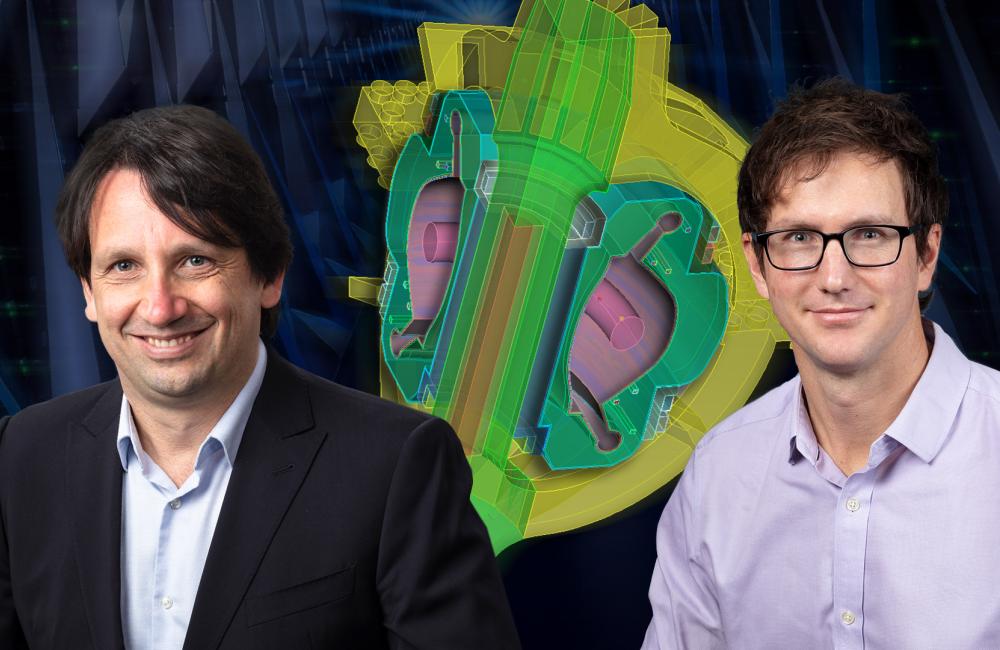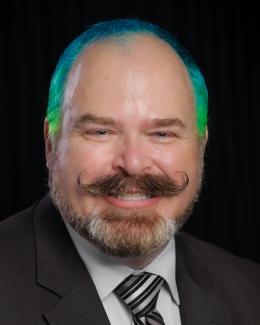Vittorio Badalassi, left, of Oak Ridge National Laboratory leads the Fusion Energy Reactor Models Integrator, or FERMI, project, and collaborates with ORNL computational physicist David Green. FERMI applies fission platforms to fusion reactor design. Credit: Commonwealth Fusion Systems and Colby Earles/ORNL, U.S. Dept. of Energy
Oak Ridge National Laboratory expertise in fission and fusion has come together to form a new collaboration, the Fusion Energy Reactor Models Integrator, or FERMI, which aims to apply a suite of predictive simulation platforms originally created for fission nuclear reactors to the challenges of designing the first generation of fusion reactors.
The FERMI project, headed by Vittorio Badalassi in collaboration with David Kropaczek, Dave Pointer and David Green, is funded jointly by the Department of Energy’s Office of Science and the Advanced Research Projects Agency–Energy, or ARPA-E, to support research and development in the technical and commercial viability of fusion energy. FERMI will benefit from ORNL’s previous expertise honed through CASL, the Consortium for Advanced Simulation of Light Water Reactors, as the new project has the potential to significantly speed up the process of bringing a commercial fusion power plant online through modeling and simulation.
“We are leveraging proven fission tools to significantly shorten the overall design cycle of a fusion reactor,” said Badalassi, a distinguished R&D researcher in ORNL’s Nuclear Energy and Fuel Cycle Division’s Thermal Hydraulics Group. “The benefit to society is that FERMI will help bring about electricity production from a carbon-free fusion reactor more quickly.”
The collaboration illustrates the synergy gained by merging fusion and fission researchers together in one organization.
“By merging fusion, fission and US ITER, we have joined together a set of capabilities on one site and in one organization that is unique. Ultimately, it enables us to be a powerful force for advancing the world toward a carbon-free energy supply,” said Kathy McCarthy, associate laboratory director of the Fusion and Fission Energy and Science Directorate at ORNL.
The name FERMI was coined to commemorate Italian physicist Enrico Fermi, who is widely credited as the inventor of the first nuclear reactor located in Chicago and who was a key scientific contributor to the Manhattan Project, which gave birth to what is now ORNL.
“This type of collaboration, together with the ability to perform the required multi-physics, multi-scale engineering calculations using ORNL's leadership-class computing facilities, is unique to ORNL,” said David Green, group leader for Plasma Theory and Modeling in the lab’s Fusion Energy Division.
FERMI’s conversion of proven, established, predictive simulation and modeling tools for fission reactors to new applications in fusion will help overcome current gaps in fusion technology design.
“For fusion, many of our predictive tools are focused on the energy-producing plasma core. This is especially true for the type of integrated modeling required to design a reactor,” said Green. “To make fusion power generation commercial, there are equally important – and integrated – engineering and technology challenges outside the core which must be solved to enable efficient energy extraction.”
FERMI is one of 14 projects nationwide selected for a competitive program funded jointly by the DOE Office of Science’s Fusion Energy Science program and ARPA-E, whose motto is “Changing What’s Possible.” The program, Galvanizing Advances in Market-aligned fusion for an Overabundance of Watts, or GAMOW, seeks to bridge gaps in technology needed to deliver a net-energy-gain fusion core and establish the technical and commercial viability of fusion energy. GAMOW’s charge specifically targets the cross-cutting R&D that FERMI represents.
The FERMI team’s focus for GAMOW is to develop an integrated simulation environment to aid in designing a fusion reactor’s blanket component. This capability is essential to delivering a fully integrated simulation platform for future fusion systems that simultaneously considers the complex plasma physics of the fusion core and the stringent engineering and functional constraints of the blanket.
“The blanket is where we capture the energy emitted from the fusion reaction, resulting in heat that is removed by a coolant and then converted to electricity using a turbine,” Badalassi said. “Designing the blanket is one of the toughest technological challenges we face as it requires materials that can survive very high temperatures and a harsh operating environment. The blanket also must be designed to serve the dual purpose of helping keep the fusion reaction going by generating tritium.”
To tackle this project, Badalassi assembled a multidisciplinary team that includes fission and fusion experts not only from ORNL but also from Commonwealth Fusion Systems, a spinoff company from Massachusetts Institute of Technology; HyPerComp Inc.; and Lawrence Livermore National Laboratory.
“Now is the time for fission and fusion experts to work together,” Badalassi said. “The synergies will be huge as fusion R&D moves from plasma challenges of the inner core to the engineering that figures out how to extract the energy from fusion for commercial production of electricity.”
UT-Battelle manages ORNL for the Department of Energy’s Office of Science, the single largest supporter of basic research in the physical sciences in the United States. The Office of Science is working to address some of the most pressing challenges of our time. For more information, please visit energy.gov/science. — Amy Reed



